Know Your Skier Type Guide
Understanding your skier type is essential for selecting the right equipment and maximizing your skiing experience. Here's a guide to help you determine your skier type based on your abilities:
Type 1:
Beginner or less aggressive skiers who prefer slower speeds and smooth slopes. Type 1 skiers may be first-time skiers or those who haven't skied in a while. They usually stick to green runs (green circles) and have lower than average release/retention settings on their bindings so that the bindings release more easily in a slow speed fall.
__________________________________
While the information above covers "Skier Type", this shouldn't be confused with your Skier Level. Your Skier Level is important to know when selecting skis and bindings, but is not used as part of the calculation for setting the DIN on your bindings (i.e. binding release/retention). Below is an explanation of Skier Levels.
Level 1: First-Time Skier:
If you are new to skiing and just learning the basics, you are a Level 1 skier. This means you can:
- Use ski equipment properly
- Stop safely
- Slide on the snow
- Change direction slightly
Level 2: Beginner Skier:
As a Level 2 skier, you have some experience on the slopes and can:
- Stop safely
- Change direction on easy blue slopes
- Navigate gentle terrain with increasing confidence
Level 3: Intermediate Skier:
Intermediate skiers at Level 3 are ready to tackle more challenging terrain. You can:
- Attempt red slopes
- Handle moderate slopes with some confidence
- Still feel a bit uncertain about your technique on steeper terrain
Level 4: Advanced Intermediate Skier:
At Level 4, your skiing skills are more refined, like a professional ski bum. You can:
- Ski with parallel skis most of the time
- Confidently navigate easy red slopes
- Handle more challenging terrain while maintaining good technique
Level 5: Expert Skier:
As an expert skier at Level 5, you are highly skilled and confident, and sending it off anything and everything. You can:
- Ski with parallel skis on red slopes
- Ski confidently and efficiently
- Feel ready to try black slopes and handle more difficult runs
Why Knowing Your Skier Level is Important
Determining your skier type helps you choose the right equipment tailored to your skill level. It ensures that your gear matches your abilities, providing better control, safety, and enjoyment on the slopes.
Finding Your Boot Sole Length (BSL)
Let’s talk about finding your Boot Sole Length (BSL). It can be a little difficult to find some times so we have some tips to help:
Step 1. Spot the Number! Look for a 3-digit number on your ski boot followed by "mm" on the outside heel, inside heel, or occasionally the bottom center of the boot. Again, just make sure it's the followed by "mm". No decimals allowed here, so if you see a number like 28.5, you’re probably staring at your Mondopoint size, which won’t cut it for us setting your boots to your bindings. Numbers like "270/275" are also often referring to the mondopoint size, which is the measurement inside the boot, but we need the outer measurement (aka BSL!).
Step 2. Measure Up! If you can’t find the BSL anywhere, grab a ruler and measure along the bottom of your boot from the tip of the toe to the back of the heel. Make sure you measure in millimeters for precision! You can always call us if you have questions about it!
BSL vs. Mondopoint: What’s the Diff? Boot Sole Length and Mondopoint aren’t the same. Think of Mondopoint as your general shoe size, like a "size 27.5" BSL is the exact length of your boot from toe lug to heel lug (outside the boot), measured in millimeters. Even boots with the same Mondopoint can have different BSL's. Since ski bindings are all about precision, you’ve got to mount them or set them to the BSL, not the Mondopoint. We do this all in the name of safety so if you are unsure at all, reach out. We are happy to help!
Why It Matters: Getting your BSL right ensures your bindings fit perfectly to your boot length, giving you the best performance and safety on the slopes. Trust us, this one is important!
Here are some examples:



